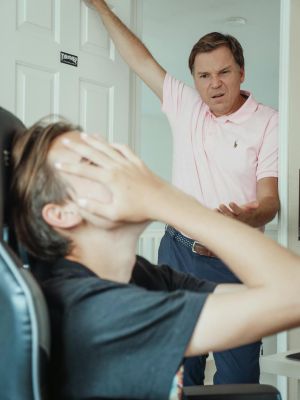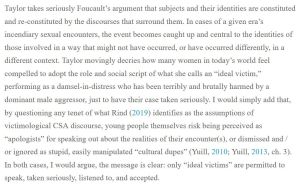One of our staff members is contributing considerably to a News Archiving service at Mu. Any well educated (Masters, PhD or above) users who wish to make comments on news sites, please contact Jim Burton directly rather than using this list, and we can work on maximising view count.
Debate Guide: The ideal victim: Difference between revisions
Jim Burton (talk | contribs) |
Jim Burton (talk | contribs) |
||
| Line 12: | Line 12: | ||
==A dangerous narrative== | ==A dangerous narrative== | ||
[[File:Idealvictim.jpg|thumb|Deeper analysis of the idealisation of victimhood]] | [[File:Idealvictim.jpg|thumb|Deeper analysis of the idealisation of victimhood]] | ||
As identified earlier, the myth of [[childhood Innocence|innocence]] and "ideal" singular abuse narrative, allows victims to suffer in silence. | As identified earlier, the myth of [[childhood Innocence|innocence]] and "ideal" singular abuse narrative, allows victims to suffer in silence. Abusers are permitted to '''hide their power''' by taking advantage of adults' biases, e.g.: | ||
*The idea that all abuse is "rapey", and that without such conspicuous telltale signs, they the perpetrator must inevitably be the "real victim" here, i.e. falsely accused as part of a "witch hunt". Gaslighting is therefore potentiated. | *The idea that all abuse is "rapey", and that without such conspicuous telltale signs, they the perpetrator must inevitably be the "real victim" here, i.e. falsely accused as part of a "witch hunt". Gaslighting is therefore potentiated. | ||
Revision as of 22:18, 13 April 2025

Abuse thrives in silence. And the singular, totalizing idea of an "ideal victim" has helped create a legal and cultural landscape where silence is the only safe option.
Blanket treatment of young people as unconsenting, also implies they can’t speak. A 14-year-old who explores a relationship with a 25-year-old, even if non-coercive and emotionally significant, will be told they were a victim, regardless of how they feel. Their voice will be dismissed as irrelevant. On the flip side, a 14-year-old who was manipulated or assaulted may fear speaking up at all: because they weren’t “supposed to be doing that,” or they worry their partner, who they still care about, will be punished.
And those attracted to adolescents, even if they never offend, are terrified of seeking help or talking openly. Therapists may be required to report them. Friends may panic. Support networks vanish. Shame and isolation grow—and so do the risks.
By mischaracterizing and stereotyping all sexual contact between adults and people below a fixed age, often 16 or 18, we don’t just create consequences for abusers. We also shut down conversation, erase nuance, and hinder prevention. We teach young people not to talk about sex, not to trust their own experiences, and not to seek help when they’re confused, curious, or even harmed. We make taboo what should be teachable.
The practical implications of this are dire. Schools teach abstinence curricula, and vague slogans instead of real emotional literacy or sexual ethics. Peers don't report abuse because they're unsure what counts, and fear what the system will do.
A dangerous narrative

As identified earlier, the myth of innocence and "ideal" singular abuse narrative, allows victims to suffer in silence. Abusers are permitted to hide their power by taking advantage of adults' biases, e.g.:
- The idea that all abuse is "rapey", and that without such conspicuous telltale signs, they the perpetrator must inevitably be the "real victim" here, i.e. falsely accused as part of a "witch hunt". Gaslighting is therefore potentiated.
- The idea that all victims are passive and female.
- A generalized, largely unspoken assumption that queer abuse victims are complicit in their abuse, or were encouraging it by way of sexual or gender identity.
- Assuming the perpetrator must fit a certain mould, their appearance or background, for example, or always being an adult.
See also
What awaits the participants
- Debate Guide: Child abuse industry
- Debate Guide: Turn of events
- Debate Guide: Blame game
- Debate Guide: The professional victim
Flawed perceptions and theory
- Debate Guide: Parenthood and pedophilia
- Debate Guide: Power disparity
- Debate Guide: Profound and lifelong scarring